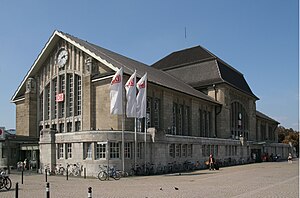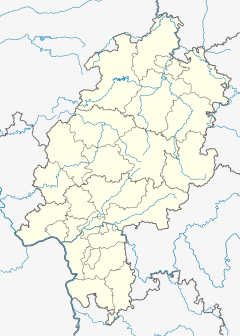
Mainz Hauptbahnhof is a railway station for the city of Mainz in the German state of Rhineland-Palatinate. It is used by about 60,000 travelers and visitors each day and is therefore by far the busiest station in Rhineland-Palatinate. The station was a trial area for a CCTV scheme using automated face recognition.

Mannheim–Frankfurt railway is a German standard gauge, electrified railway line and runs in southern Hesse and northern Baden-Württemberg between Frankfurt and Mannheim. It is also called the Riedbahn. The line runs through an area called the Hessische Ried, hence the name. The term Riedbahn was originally used for the Darmstadt–Worms railway and the two lines share the central section between Groß-Gerau and Biblis.
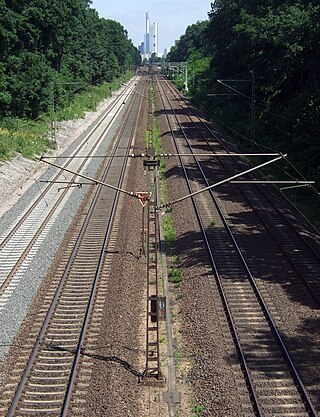
The Main-Neckar Railway is a main line railway west of the Odenwald in the Upper Rhine Plain of Germany that connects Frankfurt am Main to Heidelberg via Darmstadt, Bensheim and Weinheim. It was opened in 1846 and is one of the oldest railways in Germany.
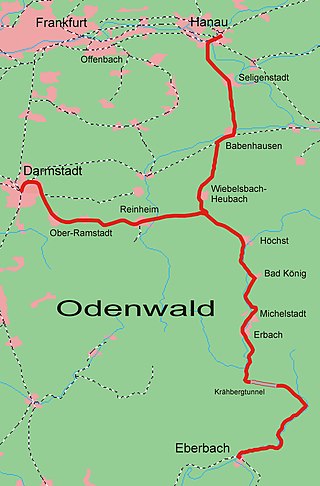
The Odenwald Railway is a mainly single-tracked main line from Darmstadt and Hanau to Eberbach on the River Neckar, which crosses the Odenwald mountains in the German states of Hesse and Baden-Württemberg. Since 1882 the route has been operated throughout as a standard gauge line and since 2005 has been worked by diesel multiples owned by the VIAS private railway company.

Offenbach am Main Hauptbahnhof is a railway station serving the German city of Offenbach am Main. It is located on the Frankfurt–Göttingen railway between Frankfurt and Hanau on the south bank of the Main. It is also the starting point of the Rodgau Railway, via Obertshausen, Rodgau and Ober-Roden to Dieburg.

The Mainz bypass railway is a bypass around the Mainz Hauptbahnhof node primarily used for freight in the German states of Hesse and Rhineland Palatinate.

Mainz-Bischofsheim station is the station of the town of Bischofsheim in the German state of Hesse on the Main Railway from Mainz to Frankfurt am Main. It is classified by Deutsche Bahn as a category 4 station. The station is served by the S-Bahn and regional trains. The station was opened at its current location in 1904.

Mainz Römisches Theater station is a station in the city of Mainz, the capital of the German state of Rhineland-Palatinate on the Main Railway from Mainz to Frankfurt am Main. It is the most important station in the city after Mainz Hauptbahnhof. It is classified by Deutsche Bahn as a category 3 station. The station is served by S-Bahn and regional trains.

Mainz-Gustavsburg station is the station of the town of Ginsheim-Gustavsburg in the German state of Hesse on the Main Railway from Mainz to Frankfurt am Main. It is classified by Deutsche Bahn as a category 5 station. The station is served by the S-Bahn and some regional trains. The station was opened at its current location in 1858.

Heppenheim (Bergstraße) station is a station in the town of Heppenheim and it is the most southerly station in the German state of Hesse on the Main-Neckar Railway between Frankfurt and Heidelberg. On weekdays the station is served by two Intercity services on the long-distance network of Deutsche Bahn. The station is classified by Deutsche Bahn as a category 5 station.
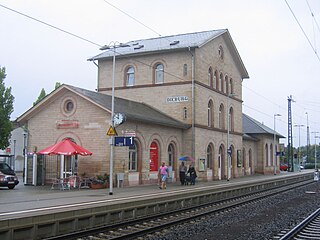
Dieburg station is located in the town of Dieburg in the German state of Hesse on the Rhine-Main Railway, which runs from Mainz via Darmstadt to Aschaffenburg. The Rodgau Railway from Offenbach am Main now ends here. The station is classified by Deutsche Bahn as a category 4 station. It is served only by local trains.

Darmstadt Nord (north) station is a junction station in the city of Darmstadt in the German state of Hesse. The passenger station, which is served by trains of the Odenwald Railway and the Rhine-Main Railway (Rhine-Main-Bahn), has four platform tracks. Running parallel and north of the station are two additional tracks for freight traffic.

Groß-Umstadt Wiebelsbach station is a station on the Odenwald Railway in the town of Groß-Umstadt in the German state of Hesse. The station is classified by Deutsche Bahn as a category 5 station. The Odenwald Railway running from Eberbach branches at the station towards Darmstadt and Hanau. The station is located in the area administered by the Rhein-Main-Verkehrsverbund.

Bad Nauheim station is a station in the town of Bad Nauheim in the German state of Hesse on the Main–Weser Railway. The station is classified by Deutsche Bahn (DB) as a category 4 station.

Langen (Hess) station is in the town of Langen in the German state of Hesse. It was opened in 1846 with the Main-Neckar Railway and is now served by the Rhine-Main S-Bahn. The station has two side platforms, an island platform and a through track without a platform. The station building and platform canopies are protected as monuments. It is classified by Deutsche Bahn as a category 4 station.

Darmstadt South station is in the city of Darmstadt in the German state of Hesse on the Main-Neckar Railway. The station building is protected under the Hessian Monument Protection Act. It is classified by Deutsche Bahn as a category 5 station.

Neu-Edingen/Mannheim-Friedrichsfeld station is a separation station in the Mannheim district of Friedrichsfeld on the border with the municipality of Edingen-Neckarhausen in the German state of Baden-Württemberg. All rail tracks are in Mannheim, only the station building is located on the territory of the Edingen-Neckarhausen hamlet of Neu-Enghien. It is classified by Deutsche Bahn as a category 4 station. It has been served by the Rhine-Neckar S-Bahn since December 2018.

Bad Vilbel station is located at the 183.6 kilometre mark of the Main-Weser Railway in the town of Bad Vilbel in the German state of Hesse. The Nidder Valley Railway branches from Bad Vilbel via Nidderau to Glauburg-Stockheim. The station is located in the network of the Rhein-Main-Verkehrsverbund. It is classified by Deutsche Bahn as a category 3 station.
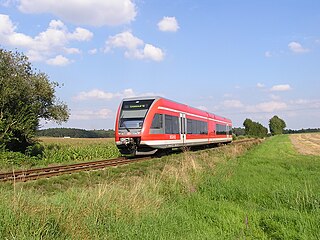
The Dreieich Railway (Dreieichbahn) is a single-track, non-electrified branch line in the Frankfurt Rhine-Main area in the German state of Hesse. It connects Dreieich-Buchschlag on the Main-Neckar Railway with Rödermark-Ober Roden on the Rodgau Railway. Colloquially, the RMV route 61 service is referred to as the Dreieichbahn, which continued beyond Ober-Roden on the Rodgau Railway to Dieburg.

Flörsheim (Main) station is the station of Flörsheim am Main in the German state of Hesse. It lies on the Taunus Railway, which connects Frankfurt and Wiesbaden.
